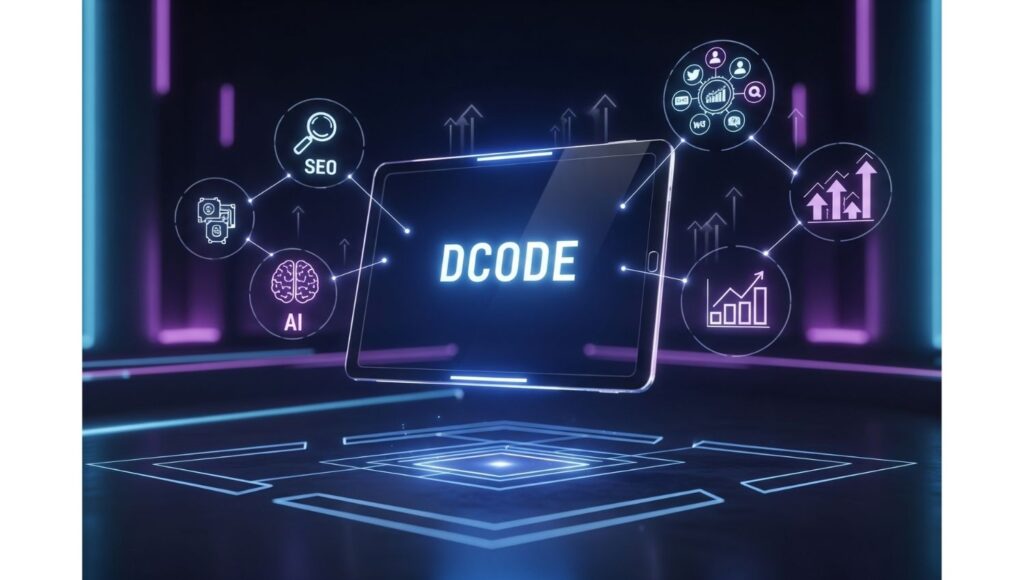Table of Contents
Digital Marketing Playbook Released—’DCODE’

Overview
The digital environment is in a state of continuous evolution, and companies have to adapt quicker than ever. In order to thrive online, a strategic playbook is no longer a choice—it’s necessary. Enter DCODE, the just-released Digital Marketing Playbook.
Created for entrepreneurs, marketers, and businesses of every size, DCODE delivers an organized blueprint for executing successful digital marketing campaigns. Developed to make better decision-making faster, easier, and less error-prone, this playbook is designed to assist businesses in prospering in today’s competitive digital marketplace.
In this article, we’ll break down what DCODE is, why it matters, the core elements of the playbook, and how it can transform your business strategy. By the end, you’ll not only understand the structure of DCODE but also see how to apply it practically in your own brand’s journey.
What is DCODE?
DCODE is a comprehensive framework for digital marketing success. The name itself represents a systematic approach:
- D – Discover: Learning about your market, audience, and competition.
- C – Create: Developing content, campaigns, and strategies.
- O – Optimize: Building and refining through performance data.
- D – Distribute: Effectively sharing content across a range of digital channels.
- E – Engage: Long-term connections with your audience.
This 5-step framework forms a loop, with businesses learning, evolving, and growing continuously in their marketing processes.
Why Do Businesses Need DCODE?
The online space is crowded, noisy, and uncertain. Firms spend a lot on advertising but do not get the desired outcome due to the lack of a well-defined plan. DCODE addresses this issue by:
- Removing Guesswork – It offers tried-and-tested strategies.
- Cutting Wastage – Companies refrain from spending money on irrelevant advertisements.
- Improving ROI – Campaigns become more targeted and measurable.
- Creating Consistency – Each step links to the next for hassle-free execution.
- Empowering Teams – Marketers, designers, and strategists align under one framework.
For startups, small businesses, and enterprises alike, DCODE offers a scalable playbook that adapts to any industry.
Step 1: Discover – Laying the Foundation
The Discover stage is all about research and clarity. Without understanding your audience, competition, and market trends, your campaigns will fail.
Key elements in the Discover stage include:
- Market Research: Determine your niche, industry, and demand.
- Audience Persona Building: Build customer profiles by demographics, behavior, and preferences.
- Competitor Analysis: Learn what the leaders in your space are doing.
- Platform Selection: Choose where your audience spends most of their time—Instagram, LinkedIn, TikTok, or YouTube.
Example: A dermatological skincare startup needs to research age demographics, skin issues, and popular beauty topics before developing campaigns.
Step 2: Create – Crafting the Digital Experience
In the Create phase, concept becomes reality. This is where content is created, campaigns are constructed, and experiences are crafted to attract and connect.
- Content Creation: Videos, reels, podcasts, infographics, and blogs.
- Website Development: Optimized and user-friendly websites for improved conversions.
- Brand Identity: Repeated design, messaging, and tone.
- Campaign Planning: Campaigning ad creatives, email, and social posts.
Pro Tip: Tell stories to produce content. Others relate to stories better than they do to sales pitches.
Step 3: Optimize – The Secret Weapon
Digital marketing is not merely about campaign creation—it’s about making them better and better all the time. This is where DCODE excels.
- SEO Optimization: Enhance search engine visibility using keywords, backlinks, and on-page tactics.
- Ad Optimization: A/B test creatives, audiences, and placements.
- Conversion Rate Optimization (CRO): Optimize user behavior and CTAs, landing pages, and funnels.
- Analytics Review: Use Google Analytics, Meta Insights, or HubSpot to track progress.
Example: A product page of an e-commerce brand can be optimized to lower cart abandonment by 20%.
Step 4: Distribute – Amplify Your Message
Distribution makes your message land with the right people at the right moment. The greatest content is worthless if it doesn’t get viewed.
- Organic Reach: Social media publishing, blogs, SEO, and community participation.
- Paid Reach: Google Ads, Facebook Ads, Instagram advertising, and influencer partnerships.
- Omni-Channel Approach: Presenting the same fundamental message on various platforms to ensure consistency of brand.
- Timing & Frequency: Posting at the best times to achieve maximum visibility.
Case Study: A SaaS business employs LinkedIn Ads, YouTube tutorials, and blog posts in combination to generate traffic and leads.
Step 5: Engage – Building Relationships
The Engage phase is where companies transition from single-sales and initiate lasting relationships.
- Community Building: Form Facebook groups, Telegram channels, or Discord servers.
- Customer Support & Feedback: Employ AI chatbots or human reps for real-time interaction.
- Email Marketing: Nurture leads with customized campaigns.
- Loyalty Programs: Reward repeat customers with discounts or special offers.
Pro Tip: Commenting, DMs, and reviews response instills trust quicker than any paid advertisement.
How DCODE is Unique Compared to Other Models
There are many marketing models, but DCODE stands out in:
- Simplicity – Simple to remember and apply.
- Scalability – Scales for small startups and global brands.
- Data-Driven – Every choice is supported by analytics.
- Customer-Centric – Long-term relationships, not immediate sales.
- Holistic Approach – Discovery through engagement in a cycle.
Real-World Applications of DCODE
- E-Commerce Brands: Employ DCODE to create customer journeys from discovery through retention.
- SaaS Companies: Use for lead generation and client onboarding.
- Healthcare Providers: Educate, engage, and offer trust-building content.
- Educational Platforms: Recruit learners, maximize enrollment campaigns, and activate alumni.
Challenges Companies Have Without DCODE
Without a systematic playbook, companies typically:
- Fumble through inconsistent campaigns.
- Squander budgets on weak targeting.
- Don’t measure performance as well as they can.
- Miss chances to engage the audience.
- Work reactively rather than strategically.
DCODE erases those issues by providing a step-by-step solution.
Future of Online Marketing with DCOD
As the future is framed by AI, automation, and personalization, DCODE will become a versatile playbook that incorporates new technologies. It keeps companies ahead of the trends rather than in pursuit of them.
Key integrations of the future are:
- Personalized content using AI.
- Voice search-optimized advertising campaigns.
- Augmented reality experiences.
- Hyperlocal targeting for small and medium-sized enterprises.
Conclusion
The release of DCODE – The Digital Marketing Playbook signifies a breakthrough for companies seeking clarity, guidance, and predictable results in the digital world.
Whether you’re a startup leader, marketing leader, or brand advisor, DCODE gives you an battle-tested playbook that converts uncertainty into strategy and ideas into tangible outcomes.
FAQs
1. What is the DCODE Digital Marketing Playbook?
The DCODE Digital Marketing Playbook is a systematic handbook crafted to guide businesses, marketers, and entrepreneurs through the intricacies of contemporary digital marketing. It offers step-by-step tactics, tools, and strategies to enhance brand awareness, drive leads, and increase ROI in the digital space.
2. Who are the users of the DCODE Playbook?
The DCODE playbook is ideal for:
Startups wishing to establish a robust digital footprint.
Small and medium-sized businesses hoping to scale.
- Marketing professionals looking for tested tactics.
- Entrepreneurs looking to maximize their internet growth.
3. What sets DCODE apart from other digital marketing guides?
Unlike broad guides, DCODE offers a practical, actionable, and data-driven guidebook. It addresses SEO, PPC, content marketing, social media, and email automation with step-by-step instructions specific to various industries.
4. Does DCODE discuss AI-powered marketing strategies?
Yes, the playbook contains tips on AI-fueled marketing tools, including chatbots, predictive analytics, and targeted campaigns, allowing businesses to remain ahead in the changing digital world.
5. Can novices use DCODE effectively?
No way! DCODE is made for everyone. Novices can learn basic strategies, whereas professional marketers can explore optimization strategies for maximum ROI.
6. Is DCODE updated regularly?
Yes, the playbook is regularly updated with the most recent digital marketing trends, algorithms, and tools so that readers have access to fresh strategies at all times.
7. How can DCODE increase my business revenue?
By implementing DCODE strategies, companies can:
- Enhance website presence with SEO.
- Drive traffic with PPC.
- Boost engagement through social media and content marketing.
- Automate customer nurturing using email campaigns.
8. Is DCODE appropriate for global businesses?
Yes. DCODE offers global strategies which are implementable worldwide, together with added insights for local SEO and regional campaigns for niche growth.


